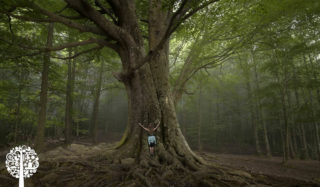If you aren’t already a tree hugger, it might be time to start hugging. The Botanic Gardens Conservation International (BGCI) has published its ‘State of the World’s Trees’ report. The findings are based on a five-year study where hundreds of experts and dozens of institutions examined the extinction risk faced by the world’s 60,000 tree species, and the news isn’t very good. Nearly 30% of the world’s tree species are facing extinction in the wild.
It is estimated that 17,500 species of trees are at risk, ranging from tropical timber trees to traditional oaks and maples. The number of tree species facing extinction is twice that of at-risk birds, amphibians, reptiles, and mammals combined. As a result, conservation groups urgently call for protection measures in the face of threats such as climate change, logging and deforestation.
Crucial To Life
As the largest plants on earth, trees are vital to survival. They benefit human health by trapping dust and absorbing pollutants in the air (up to 1.7 kg per year per tree), providing shade from the sun’s rays, and even reducing noise. In addition, they can provide food for nutrition, and some also have medicinal properties.
Trees produce oxygen, absorb carbon dioxide, and store carbon, which helps slow down the rate of climate change. Trees can also slow wind speeds and cool the air temperature. Research estimates that trees can reduce the temperature in a city by as much as 7°C. They also offer excellent protection against flooding and soil erosion by absorbing enormous volumes of rain and stormwater.
Trees offer habitats and food for birds, small mammals, insects and fungi; one mature oak tree can house up to 500 different species! Over time, the hollow trunks of trees can also provide the cover needed by bats, woodboring insects, owls and woodpeckers.
The longest living species on earth, trees are also a link between the past, the present and the future and have many social and economic benefits. For example, green areas such as parks and local woods bring communities together and encourage outdoor pursuits. They can also help increase property prices and the desirability of places with access to an abundance of green space.
“We have nearly 60,000 tree species on the planet, and for the first time, we now know which of these species need conservation action, what are the greatest threats to them and where they are.” -Dr Malin Rivers, Botanic Gardens Conservation International. London.
The Most At-Risk
Trees at a higher risk of extinction include oak trees in Mexico, Chile, and Argentina, lost to farming and development. Dipterocarps are large tropical trees disappearing rapidly due to the demand for palm oil and the expansion of plantations. Rosewood and Ebony trees have fallen victim to timber logging in Madagascar; Magnolia trees are also dying off due to unsustainable plant collecting. Natural pests and diseases kill Ash trees in many parts of North America and the UK.
The biggest threats to the global tree population:
- Forest clearing for crops (29%)
- Logging (27%)
- Land clearance for livestock (14%)
- Land clearance for building development (13%)
- Fire destruction (13%)
There’s Hope
With conservation action, however, there is hope for the future. The World Trees report identifies the issues clearly and is an excellent tool for raising awareness and mobilising the community to address these threats immediately. Environmental experts say expanding protected areas worldwide will help, as will storing endangered tree genetics in botanic gardens or seed banks. We must also follow tree planting and reforestation guidelines; suitable trees must go to the right places.
If this all sounds a bit urgent, that’s because it is! Around 142 species have already disappeared from the wild, and hundreds more are headed for the same fate. All living things need a healthy, diverse range of trees. Each one has a unique role within the ecosystem – let’s all do our part to save them.

